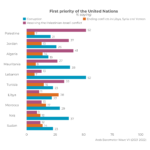The Trump administration’s surprising announcements and foreign policy shifts
President Trump made numerous foreign policy announcements that left U.S. and foreign officials scrambling. Perhaps the most consequential, as Morgan L. Kaplan explained here, was Trump’s October decision to pull U.S. troops out of Syria, leaving Kurds vulnerable to Turkish and Russian attacks — and possibly enabling Islamic State fighters to regroup and return to the fray. As Turkey invaded Syria, polling data from Anna Getmansky, Tolga Sinmazdemir and Thomas Zeitzoff showed that most Turks supported the invasion and have turned against Syrian refugees.
That was just one of many. In March, Trump tweeted that the United States would recognize Israel’s authority over the Golan Heights, territory that Israel annexed from Syria after the 1967 war. This move probably “undercut efforts to build a lasting peace with the Palestinians and may even unsettle Israel’s treaties with Egypt and Jordan,” Stacie Goddard explained here.
In April, Secretary of State Mike Pompeo — in a first for the United States — designated a foreign government entity, an Iranian military unit, as a “terrorist organization.” Afshon Ostovar argued that the move would hurt already fraught U.S. relations with Iran. Meanwhile, Jason Brownlee wrote about new survey data suggesting that U.S. military confrontation with Iran would be unpopular with Americans.
Protests erupted across the region
Protesters took to the streets around the world in record numbers, including in numerous Middle Eastern countries in 2019. Monkey Cage editor Marc Lynch wrote about the significance of the protests in Sudan in December 2018 and Algeria in February.
In early 2019 — after a nine-month impasse — Lebanon’s political elite agreed to a new government. Jeffrey G. Karam explained the challenges and opportunitiesfacing the country, foreshadowing both the reforms called for by protesters and possible changes to U.S. aid. Christiana Parreira and Kelly Stedem explained that Lebanon’s unprecedented protests spread across the country. Bassel F. Salloukh wrote about how a proposed government tax on the free WhatsApp messaging service could have sparked the protests, given simmering outrage over an extended lack of basic services. Karam explained why the protests continued even after the prime minister resigned.
Meanwhile, in Iraq, anti-government protests continued for months, even after Iraqi militias attacked and killed protesters — attacks that Renad Mansour, Thanassis Cambanis and Michael Wahid Hanna explained are supported by the Iraqi government. Despite 300 protester deaths, Munqith Dagher explained, new survey data showed why Iraqis continue to demonstrate: Although these protests haven’t yet changed the system, he argues, they’re transforming Iraqis’ belief in themselves.
In Algeria, protests began early this year over structural changes to the country’s government — and continued through the end of the year for reasons Rayane Anserexplained. Nonpartisan research network Arab Barometer and Michael Robbinsbrought us new survey data that revealed, as Robbins wrote, that “ordinary Algerians appear less concerned about specific political and institutional arrangements than they are about having a responsive government that provides for their basic needs.”
In November, the Iranian government reacted quickly and violently to anti-government protesters — killing more than 100 people and shutting off the Internet to the entire country for a week. Mohammad Ali Kadivar argued that while the Iranian government’s crackdown may have quelled protesters, such tactics may not work if protests continue. The region’s widespread ongoing protests probably prompted Iran’s government to crack down, as Dina Esfandiary wrote: “Tehran is both confident regarding the weakness of its population … and less confident of its standing in the region because of ongoing protests in Lebanon and Iraq.”…


